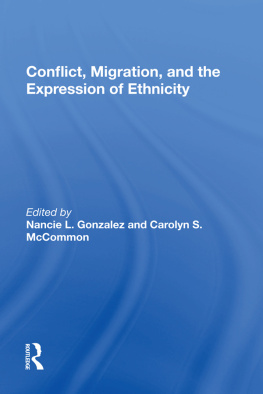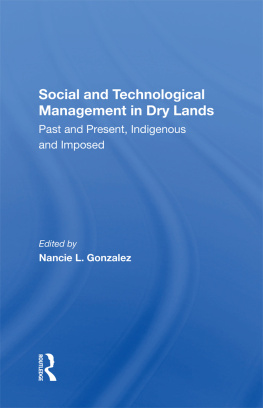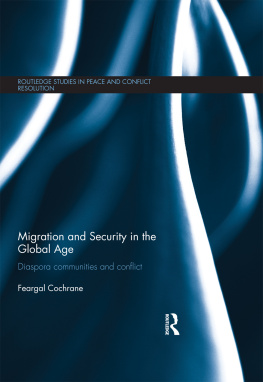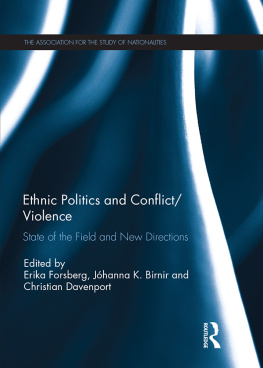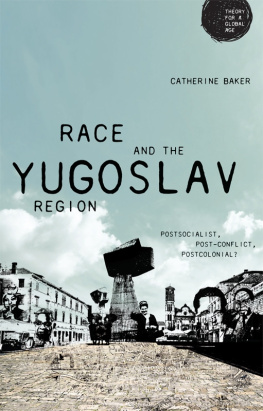First published 1989 by Westview Press
Published 2019 by Routledge
52 Vanderbilt Avenue, New York, NY 10017
2 Park Square, Milton Park, Abingdon, Oxon OX14 4RN
Routledge is an imprint of the Taylor & Francis Group, an informa business
Copyright 1989 Taylor & Francis
All rights reserved. No part of this book may be reprinted or reproduced or utilised in any form or by any electronic, mechanical, or other means, now known or hereafter invented, including photocopying and recording, or in any information storage or retrieval system, without permission in writing from the publishers.
Notice:
Product or corporate names may be trademarks or registered trademarks, and are used only for identification and explanation without intent to infringe.
Library of Congress Cataloging-in-Publication Data
Gonzlez, Nancie L. Solien, 1929-
Conflict, migration, and the expression of ethnicity / by Nancie
L. Gonzlez and Carolyn S. McCommon.
p. cm.(A Westview Special Study)
Bibliography: p.
Includes index.
1. Ethnicity. 2. Emigration and immigrationSocial aspects.
3. Ethnic relations. I. McCommon. Carolyn Sue. II. Title.
GN495.6.G661989
305.8dc19
88-10655
CIP
ISBN 13: 978-0-367-01221-2 (hbk)
1
CONFLICT, MIGRATION, AND THE EXPRESSION OF ETHNICITY: INTRODUCTION
Nancie L. Gonzalez
The three topics joined in this book are not new in anthropology. Each has a large and respectable literature, much of which has become classic, even outside the discipline. The contributors, however, share the conviction that we still have much to learn about the inter-relationships among them - how conflict both produces and is a product of migration, and how ethnic phenomena are interwoven with both. It is not our intent to define the slippery concept of ethnicity; indeed, most of the authors recognize that different investigators and theorists have used and will continue to use it in quite different ways (see Cohen 1978, Royce 1982, Riggs 1985). Like the concept of culture itself, ethnicity is a theoretical construct that we use to help us understand and explain certain kinds of things, events and behavior that we observe in the field.
Similarly, conflict and migration may also be variously defined by different investigators. Although we hope the case studies included here will shed light on all three, we warn the reader at the outset that we do not pretend to offer a unified theoretical treatment of them; rather, each author presents a situation in which the data seem illuminated by using these three conceptual variables - sometimes following the lead of other investigators, and sometimes in novel formulations. The following is an attempt to set forth some of the common understandings about these concepts as they are used in this volume, together with a glimpse of how each presentation is related to the others and to the whole.
Ethnicity as an Ethnographic Category
Probably the social groupings most frequently observed by ethnographers working in complex societies are those bound together by a common language, religion, domestic values, and kinship - in other words, by the ethnographic characteristics by which anthropologists have long recognized and described human cultural variation. Once we termed the ethnographic units we discovered peoples and cultures, and Iaypersons callcd them tribes or nations, but with the rise of multinational states and their incorporation of once-autonomous peoples within their political folds, ethnic group has become the more customary designation of such units by both anthropologists and others.
Most ethnographic observations have been focused on small, local units at relatively simple or lower levels of sociopolitical integration, although in recent years anthropologists have more and more contributed to studies of global sociocultural systems. In the latter endeavor, it is now commonplace for anthropologists to study various kinds of constituent groups in plural or pluralistic societies, as well as macrolevel phenomena associated with nations, states, and international institutions and organizations that crosscut the latter.
Only Burns and Diskin here deal with the kinds of societies that have traditionally been considered grist for the anthropological mill. In all the other papers, the ethnic subjects arc named for the country from which they have migrated or derived - Salvadorans, Guatemalans, Greeks, Turks, and in the case of the Palestinians in Lebanon and in Honduras, by the name of a non-existent country whose citizens are nevertheless bound together in diaspora in their dream of regaining lost territory and of creating a nation therein. There is virtually no concern over whether we are dealing with ethnic groups or categories, with boundaries or content, although all the contributors seem to agree that there arc ethnic phenomena involved.
Most of the authors are not bothered by this problem of ethnic apples and oranges, although Mandel properly cautions us against both the laundry list way of defining an ethnic group and against the danger of reifying ethnicity-making it into an objective entity that is somehow out there waiting to be studied. Anticipating Mandel, I believe it is fair to say that most of the present authors have used a folk, rather than an analytic definition of ethnicity in thinking about their subjects. In one sense, it is a professional folklore, deriving principally from anthropology; but political scientist Rubenberg, coming from a different tradition, tends to think of ethnicity in another light-ironically, she alone refers to Barths notion of primordial ethnic attachments, although she also believes that in the case of Lebanon, factors other than ethnic rivalry catalyzed the conflict. Indeed, a primary conclusion that can be drawn from alt the papers, is that the definition of both self and group in ethnic terms is enhanced, if not actually generated, by the conflict/migration/conflict situations in which the subjects of our papers have found themselves. This is not how early anthropologists accounted for the origin of ethnic phenomena, although ethnohistorians have now demonstrated that some groups, such as the Miskitu may indeed have originally been the product of local conflicts and migrations brought about by the expansion of Europeans into the New World-itself a process involving all three concepts (Helms 1971).
This discussion continues to beg the questions of how we define ethnicity, how we know it (or its symbols, or its boundaries, or its scope, etc.) when we see it, and how we treat and evaluate it in relation to other variables. For most of the authors, ethnicity is treated as a given; it is not itself the primary focus of their analyses. In each case it tends to be seen and accepted in emic terms, i.e., as the people being observed define themselves and others. Except for instances in which the author is self-consciously dealing with the concept of ethnicity, this is how most anthropologists handle it in their descriptive works. Thus, the papers vary in whether they deal with relationships, symbols, or stereotypes. Most include at least a cursory review of both internar and external definitions of the groups ethnic identity. Durhams contribution picks up from the questions raised here and by Mandel, giving us further thoughts on the definition of ethnicity than are found in the papers themselves, which concentrate more on how ethnicity is expressed under the circumstances described.

